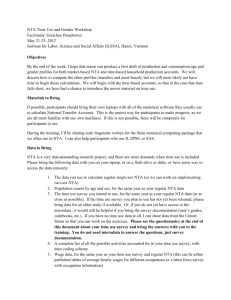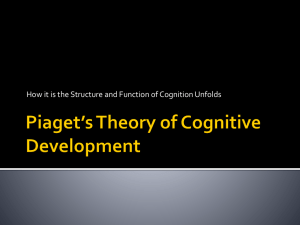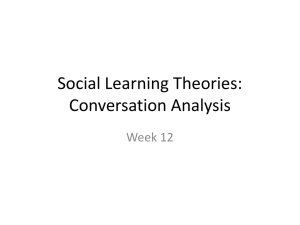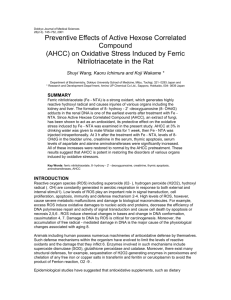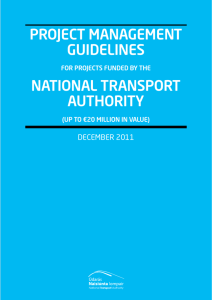Bayesian estimation and projections in NTA frameworks, Details of a
advertisement
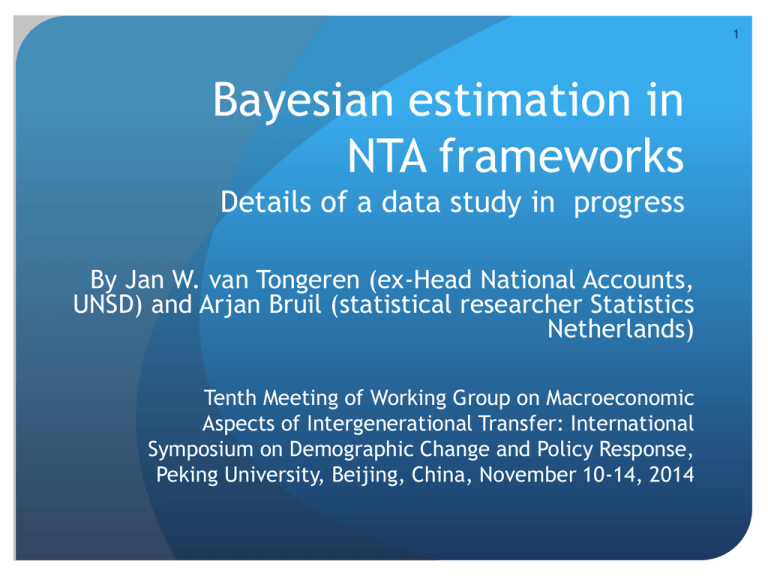
1 Bayesian estimation in NTA frameworks Details of a data study in progress By Jan W. van Tongeren (ex-Head National Accounts, UNSD) and Arjan Bruil (statistical researcher Statistics Netherlands) Tenth Meeting of Working Group on Macroeconomic Aspects of Intergenerational Transfer: International Symposium on Demographic Change and Policy Response, Peking University, Beijing, China, November 10-14, 2014 Links to parallel paper on ”Analyzing Wealth through an Integrated Economic and Demographic Framework, the case of the Netherlands” 2 This presentation uses the same data and concepts as used in the parallel paper presented in this meeting by the authors. The links between SNA and NTA and also concepts used in this presentation are explained the parallel paper The paper does not deal with non-market output beyond the SNA production boundary, or with intra-HH transfers. It also does not measure Transfer Wealth. These topics are all dealt with in the parallel paper. The presentation is a progress report on the work of Bayesian estimates in a NTA framework and does not yet include quantitative results 3 Keywords Frameworks Bayesian estimation Frameworks are Sets (vectors, matrices and tables) of (generally, a very large number of) variables, with Interrelationships (identities and ratios) defined between the variables Data are generally available on a limited data set and/or inconsistent; identities do not hold between them Reliabilities of values of data and ratios are set as priors by statisticians, using their detailed statistical knowledge and experience Data, ratios , identities and reliabilities are used to arrive at comprehensive estimates, covering all variables of the framework 4 Examples of Frameworks National accounts, with only monetary data Health and education accounts, with monetary and demographic data Environmental accounts, monetary data with data on emissions, mineral resources, water and land use Framework for demographic projections, with demographic data only NTA, with monetary and demographic data 5 Frameworks define analysis Through: Selection of variables and data: in NTA economic and demographic data and variables are selected for analysis Definition of concepts: in NTA are defined concepts of HH actual final consumption Including individual consumption of GOV and NPI, in order to show total consumption of the population on education, health, housing and other, whether financed or not by HH’s in basic prices, excl. production taxes less subsidies, in order to assess age impact of production taxes and subsidies Transfers in kind, assessing the age impact on transfers of GOV and NPI individual consumption of education, health, housing and other Adjustments for changes in pension and other entitlements, that define the link between transfers in the flow accounts and Transfer Wealth in the balance sheets Transfer Wealth covering the present value of claims that HH’s have on future wealth Balancing items constituting main aggregates: life cycle, transfer and asset based income deficits/surpluses Ratios: age profiles of selected transactions, compensation of employees and mixed income per worker, social premiums and benefits per worker, final consumption per individual, etc. 6 7 Simple Framework Elements of framework Variables: 14 Data: 14 Ratios: 10 Identities: 8 (2 dependent) Information items: 30 Bayesian estimation, simple example 8 The graph illustrates the twodimensional estimation of C and Y, under conditions of identities, ratios and fixed reliability intervals of data and ratio’s. It shows how minima and maxima of data (C and Y min/max), ratios (C/POP min/max) and identities (C Supply=Use) limit posterior intervals of variables C and Y (between points β and γ) and may even result in exact estimates (point ε), if an additional restriction (Y=R) is added. 9 Bayesian, formalized approach The Bayesian estimation applied in our approach uses a normal distribution of the reliability of data values instead of the fixed reliability intervals. n ( 1 å s Xi -Xi The method is equivalent to the generalized least square estimates of Xi (i=1,2,….n), by minimizing under conditions of j (1,2,…,m) identities fj(X1,X2,…..,Xn)=0 i=1 2 i Xi are the variables to be estimated, X are the prior values of the data. σi are the prior standard deviations of the data i Ratios are linearized and are added as linear restrictions to the identities. Posterior values of Xi and σi are estimated as a result of the Bayesian estimation approach ) 2 NTA framework (i) sector accounts NTA Framework, sector accts. = Extended HH sector accts., incl. NPI’s Comprehensive NTA framework, sector accts. incl.non-HH sector accts. 10 NTA framework (ii) balance sheets 11 NTA Framework, balance sheets = Extended HH sector balance sheets Incl. NPI’s, plus balance sheets of a HH sector breakdown by ages Comprehensive NTA framework, balance sheets incl. non-HH sector balance sheets Reliabilities of data in NTA framework Reliabilit y symbol Quality of data/ratio value Reliability coefficient, prior F1 Near-fixed +/- 0.001 S Superior +/- 0.010 H High +/- 0.030 M Medium +/- 0.060 L Low +/- 0.120 P Poor +/- 0.240 Micro data are included as data and in ratios, if their total is between 80% and 120% of the macro data. If less than 80% or higher than 120%, micro data are only included in ratios (next page) 12 Ratios define analysis in NTA framework 13 Identities define consistency between values of variables in NTA framework Identities defining consistency between HH sector variables and age-breakdowns using micro data Identities defining consistency between sector variables and variables of the total economy and rest of the world Identities defining SNA and NTA aggregates (e.g. labour income) and balancing items (e.g. NTA life cycle surplus/deficit, transfer surplus/deficit) and SNA aggregates and balancing items (e.g. GDP, saving, changes in net worth) in terms of individual transactions Identities in balance sheets between opening closing balance sheets and changes in asset accounts Identities defining consistency between flow accounts variables and balance sheet variables (e.g. changes in net worth) 14 Objectives of study Define NTA framework in which Bayesian estimates are made. This work is done Work-in-progress Comparison of posterior and prior reliabilities of comprehensive NTA framework, showing how much a framework orientation contributes to improvement of reliability of estimates Comparison of posterior reliabilities between NTA framework with only monetary data and a framework in which also population and micro data are included. This is to asses the improvement of the reliability of NTA and SNA estimates, using additionally micro and population data that are not used by national accountants Estimation of comprehensive framework, when only a limited data set is available. The results of this work could be used, when national accounts is mainly limited to GDP data Projection of a limited data set to the future and estimating the remaining variables with help of the Bayesian estimation method 15 16 Obstacles for NTA implementation lack of information on the link between economic and demographic data, and limited cooperation between national accountants and demographers Difficulty of finding age related micro data that are reliable alternative to estimation of the macro variables Focus in national accounting on GDP and not on sector accounts and and balance sheets; sector accounts are the main source for the NTA data Lack of consistency between flow accounts and balance sheet data
